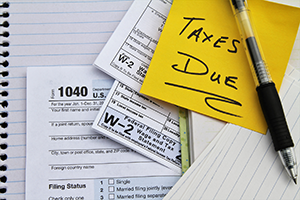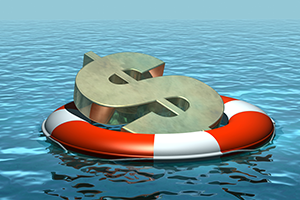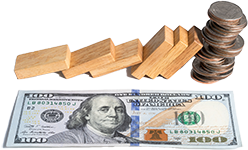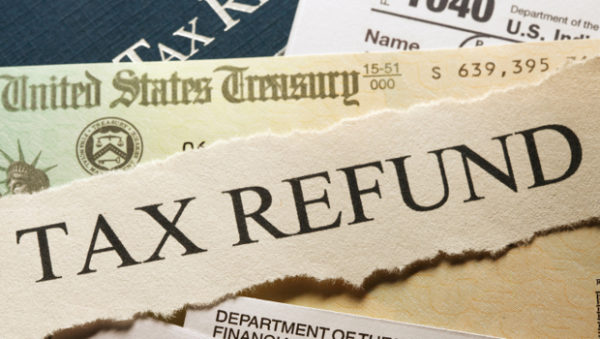March 15
– Due date for partnership and S corporation tax returns (Forms 1065, 1120S)
Missing tax documents can mean missing the date you’re hoping to get your tax refund. In this month’s newsletter, read about common tax items that if missing, could cause a delay in filing your return.
Also read through several ideas for building an emergency fund when money is scarce, ideas to consider when interest rates change, and the perils of too much social media.
Please enjoy the information and pass along articles of interest to all your family and friends. And as always, please call if you have questions or need help.
Common Missing Tax Return Items

Want your tax return filed quickly and without error? Then double-check this list of items that are often overlooked. These missing items often cause delays in getting your tax return filed:
- Forms W-2 and 1099. Using last year’s tax return as a checklist, make sure all your W-2s and 1099s are received and applied to your tax return. Missing items will be caught by the IRS mismatch program. All these forms are required to be in the mail to you on or before Jan. 31. If you are missing a form, contact the company responsible for issuing them.
- Dependent information. If you added a new dependent in 2023, provide the name, Social Security number and birth date to have them added to your tax return. If you have a dependent that shares custody with someone else, discuss the plan for who is going to claim them. Your tax return cannot be filed if there is conflict in this area.
- Cost basis information. If you sold any assets (typically investments or real estate), you need to know the cost basis amount to calculate your taxable capital gain. Check your investment statements to ensure that your broker includes the required information. Sometimes it’s difficult to find this information on the Form 1099-B summary, but it might be listed later in the statement details.
- Schedule K-1s. As an owner of a partnership or S-corporation, you will need to receive a Form K-1 that reports your share of the profit or loss from the business activity. When you receive your K-1, pay special attention to box 17 (code V) for S corporations and box 20 (code Z) for partnerships. This is where information is included for the Qualified Business Income Deduction.
- Digital asset transactions. If you are buying or selling cryptocurrency or other digital assets, you will need to provide details to support the cost basis and sales price of each transaction.
- Forms or documents with no explanation. If you receive a tax form, but have no explanation for the form, questions will arise. For instance, if you receive a retirement account distribution form, it may be deemed income. If it is part of a qualified rollover, no tax is due. An explanation is required to file your information correctly.
- Missing signatures. Both you and your spouse need to review and sign the e-file approval forms before the tax return can be filed. The sooner you review and approve your tax return, the sooner it can be filed.
By knowing these commonly missed pieces of information, hopefully your tax filing experience will be a smooth one.
Building an Emergency Fund When Cash is Scarce

The traditional rule-of-thumb for emergency funds is to have enough cash stashed away to cover 3 to 6 months worth of expenses. For many people, though, this sounds better in theory than in practice.
When you’re starting from scratch and don’t have a lot — or any — extra cash at the end of the month, consider these ideas to help grow your emergency fund.
Cutting Expenses
- Review recent statements to find opportunities to save. Look over your bank statements and credit card bills from the last few months to see where all your income is going. Spend some time tallying up expenses in categories you have some control over, such as entertainment, dining out, clothing and online shopping.
- Cut down on lifestyle expenses. Identify areas to cut your spending and create new spending goals in categories that were problematic in previous months. Some of the easiest places to cut include online shopping, subscription services, clothing, movies and music. Once you reach your emergency fund goal, you can consider adding some of these spending areas back into your budget.
- Spend less on food. One of the biggest budget busters for many families is their spending on food — both at the grocery store and at restaurants. Control food spending by making a meal plan and cooking most of your meals at home, shopping sales at the supermarket, and making meals with ingredients you already have.
Increasing Income
- Squirrel away windfalls. Consider adding windfalls such as tax refunds, work bonuses, or annual gifts you may receive from a family member to your emergency savings as soon as you receive it.
- Sell stuff you don’t need. Look around your home for items you rarely use and then sell unwanted stuff using an online marketplace. Used items that can fetch a good sales price include workout equipment, brand name clothing and accessories, small furniture and antiques.
- Add a part-time job or side hustle. Boost your income by picking up more shifts at work, asking for overtime, or getting a second job or side gig to fill your spare time. This step can help you bring more money home so you can add to your emergency fund.
Once you start looking for ways to spend less and earn more, there’s one final step that can help you grow your emergency fund. Make sure the money you find on both ends of the spectrum makes its way to your savings, either through manual or automatic transfers.
The best way to do this is by having a dedicated emergency fund in an account that’s separate from your regular checking and savings accounts. By moving your extra money into this account, you can grow your emergency fund with less temptation to spend it.
Important Moves to Consider When Interest Rates Change

A domino effect occurs each time the Federal Reserve changes interest rates. An increase leads to higher rates for consumers when they borrow, while paving the way to better returns for savings accounts. A decrease results in paying less interest when borrowing money, but also causes a drop in how much your savings can earn.
While waiting to see what the Fed does in 2024, consider having a plan in place for both these scenarios — a hike in interest rates as well as a cut. Here are some ideas for formulating your own financial plan for each scenario.
When Interest Rates Increase
- Shop around for new savings accounts. Rate increases are good for long-term savers and families who are stashing away money for short-term goals like buying a home. When interest rates are on an uptick like they are right now, it’s a great time to shop around for a high-yield savings account or to lock in a great rate for a portion of your savings with a certificate of deposit.
- Focus on paying down high interest debt. Rate increases can create disastrous results for people who have debt with variable interest rates. For example, data from the Fed shows the average credit card interest rate increased from 14.22% in 2018 to 21.19% in the second half of 2023. If high-interest debt is dragging you down financially, rate increases give you more incentive to pay it off.
- Avoid borrowing when possible. Surging interest rates make borrowing money more expensive, so try and avoid borrowing for personal and business reasons. If you must borrow, attempt to exhaust every other source of cash before taking on new debt.
When Interest Rates Drop
- Refinance existing debts. Look into consolidating or refinancing all your existing debts, including your mortgage, personal loans, and credit cards. Lower rates can help you save money on interest, secure a lower monthly payment, and help you pay off a debt’s balance more quickly.
- Look for ways to put additional funds to good use. Lower interest rates make it less appealing to stash money away in savings account products, money market accounts, and certificates of deposit. Instead of savings accounts that feature little or no interest, look for ways to invest for the future or put your money to use for things you need.
- Apply for funding. Rate drops also maketa borrowing money more attractive. Consider applying for a personal or small business loan, but only if you have a plan for it.
Oh No! Your Tax Refund is Now a Bill

Many taxpayers start preparing their tax return with hopes of receiving a sizable refund, only to find out that their actual refund is much smaller than expected — or that they actually owe the federal government money instead! If this happens to you, here are some of the likely reasons:
- Higher take-home pay. Look at last year’s W-2 and see how much was withheld for federal income tax. Now check this year’s W-2. If it is lower, you will need a corresponding reduction in your tax obligation to get the same refund as last year. The good news? You’ve had more of your income available to you throughout the year. The bad news? Paying less tax each pay period can result in a lower refund or even a tax due balance at tax filing time.
- Withholding tables are not always accurate. The IRS provides businesses with tax tables to figure out how much of your paycheck should be withheld to pay your taxes. While these tables are mostly accurate, sometimes these tables instruct your employer to withhold more than necessary — leading to a refund. But sometimes the opposite is true and your employer may not withhold enough — leading to a balance due.
- You earned money from a side hustle. You are responsible for making payments to the IRS for taxes you owe from working a side hustle or as a freelancer. If you didn’t make these payments to the IRS as you were earning the money throughout the year, you’ll have to make a lump-sum payment when you file your tax return.
- Your state takes a different path. Tax laws passed by many states closely mirror tax laws passed by the federal government. But many times these laws never match 100%. This means that while you may see a refund on your federal tax return, you might end up owing money on your state tax return.
With the uncertainty of whether or not you’ll receive as large of a refund as you’re expecting, consider holding off on plans to spend your refund until your tax return is finalized.
